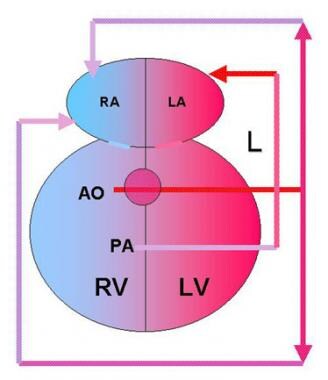Background
Double outlet right ventricle (DORV) refers to a heterogeneous series of associated cardiac anomalies that involve the right ventricular outflow tract in which both of the great arteries arise entirely or predominantly from the right ventricle. The anatomic dysmorphology of double outlet right ventricle can vary from that of tetralogy of Fallot (TOF) on one end of the spectrum to complete transposition of the great arteries (TGA) on the other end (see the image below).
Double Outlet Right Ventricle Surgery. Double outlet right ventricle (DORV) with transposition of the great arteries accounts for 26% of cases of DORV. The aorta (AO) is anterior and to the right of the pulmonary artery (PA), and both arteries arise from the right ventricle (RV). The only outflow from the left ventricle (LV) is a ventricular septal defect (VSD), which diverts blood toward the RV. Pulmonary veins drain into the left atrium (LA) after blood has been oxygenated in the lungs (L). Systemic venous return is to the right atrium (RA).
In the United States, the incidence of double outlet right ventricle is an estimated 0.09 cases per 1000 live births. Double outlet right ventricle comprises about 1-1.5% of all congenital heart disease.
No specific causal agent or predictive event has been identified.
The clinical presentation can vary from one of profound cyanosis to that of fulminant congestive heart failure. As a result, management and surgical repair of the defect are based on correcting the specific combination of anatomic defects with their radically different pathophysiologies.
Although hearts with atrioventricular discordance (ie, congenitally corrected TGA) or univentricular atrioventricular connections (ie, double inlet left ventricle) can be correctly grouped in this spectrum of anomalies, this article focuses on only those hearts with atrioventricular concordance and two functional ventricles.
History of the procedure
In 1793, Aberanthy described a heart with the origin of both great arteries from the right ventricle.
The designation of “double outlet ventricle” was probably first reported by Braun et al in 1952.
The first successful biventricular repair for this entity was reported by Sakakibara et al in 1967.

